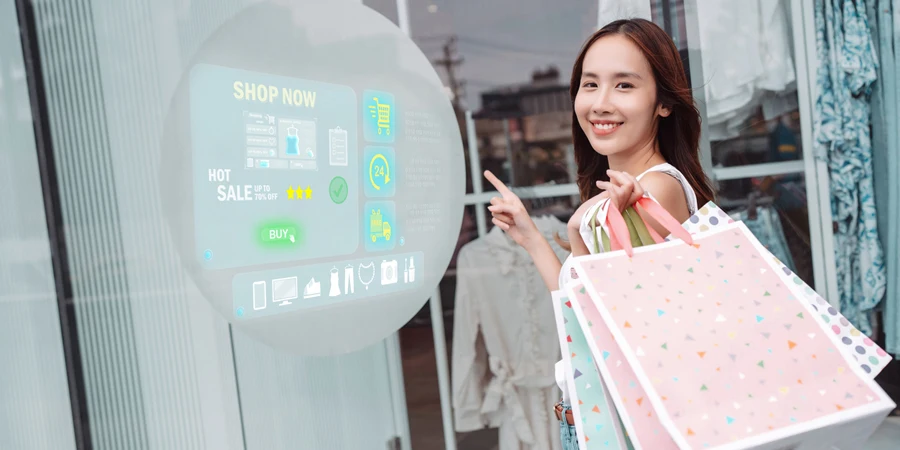The future of retail will be defined by a connected marketplace, where customers can seamlessly transition between physical and digital experiences.
Emerging technologies such as AR, VR, and AI will play a critical role in creating this connected experience by providing personalized and immersive shopping experiences that cater to the individual needs and preferences of each customer. These technologies can be used to create personalized and immersive experiences that engage customers and differentiate brands from competitors. The retail industry has undergone a rapid transformation over the past decade with the adoption of these new technologies. Retailers now have the potential to enhance the customer experience by providing personalized and immersive shopping journeys. This whitepaper aims to explore the role of AR, VR and AI in the future of retail and how they will shape the connected experience.
AR in Retail
AR refers to the overlay of digital content onto the physical world, typically through the use of a smartphone or tablet. AR can be used in the retail industry to provide customers with an immersive and interactive shopping experience. Consumers can use AR to try on clothing virtually, visualize furniture in their home, or see how a shade of lipstick will look once applied. For example, IKEA’s Place app uses AR to allow customers to preview furniture in their homes before making a purchase. This reduces the likelihood of returns and improves the overall shopping experience.
AR can also be used to enhance the in-store experience. Retailers can use AR to provide customers with information about products, such as ingredients or reviews, by scanning a product with their smartphone. AR can also be used to create interactive displays or games that engage customers and encourage them to spend more time in-store. This mobile-enhanced experience is quickly becoming an expectation for the digital-first consumer.
VR in Retail
VR technology creates a fully immersive digital environment that simulates the physical world. In retail, VR can be used to create virtual stores that customers can explore and interact with. This allows customers to experience products in a more immersive and engaging way, which can lead to increased sales and customer loyalty.
VR can also be used to create virtual showrooms where customers can customize and visualize products before making a purchase. This not only improves the shopping experience but also reduces the need for physical inventory. VR can also be used to train employees or simulate scenarios, such as a busy store during a holiday shopping season. This can help retailers improve operational efficiency and reduce costs.
AI in Retail
AI refers to the ability of machines to perform tasks that typically require human intelligence, such as learning, reasoning, and problem-solving. AI can be used in the retail industry to personalize the shopping journey for each customer. For example, retailers can use AI to analyze customer data, such as purchase history and browsing behavior, to make personalized product recommendations or offer targeted promotions.
AI can also be used to improve operational efficiency by automating tasks such as inventory management, supply chain optimization, and customer service. This can help retailers reduce costs and improve the overall customer experience.
While the mobile, social-first world presents significant opportunities for retailers, there are also several challenges that must be addressed. One of the biggest challenges is the need to create a seamless and consistent experience across all platforms and touchpoints, including in-store, online, and mobile. Brands and retailers must reset the way strategize, plan, and launch product and storytelling to meet the new, connected consumer expectation.
The biggest challenge is the cost and complexity of implementing these technologies. Retailers must adapt to this new reality by ripping up the old playbook and thinking about investing differently in their go to market strategy.
Actions to take:
- Define how these emerging technologies can best support the strategies of your brand or retail experience.
- Find opportunities to redirect budget to invest in a connected experience.
- Drive collaborative, cross-functional, planning. A connected team will deliver a more seamless experience.
- Think big, work small, and go fast! Find the right manageable opportunities to iterate, learn and prove concepts that can scale and evolve at the speed of technology and culture.
About Christopher Massaro
Chris is an industry leading influence in retail and brand design, with a career dedicated to delivering world class consumer experiences. Chris has led the creative in support of the largest and most influential brands in footwear, apparel, consumer electronics, and food & beverage. In 2020, Chris was named to Design:Retail’s 40 under 40, recognizing his achievements throughout his 20 years in the industry. Prior to joining SGK, Chris was a client partner in a Global Creative Director role at Under Armour. As VP, Creative & Design at SGK, Chris currently leads the creative teams for SGK Brand Experience
Source from SGK
Disclaimer: The information set forth above is provided by sgkinc.com independently of Alibaba.com. Alibaba.com makes no representation and warranties as to the quality and reliability of the seller and products.




